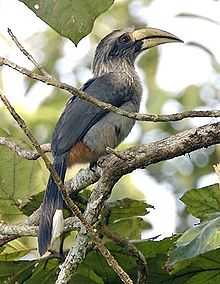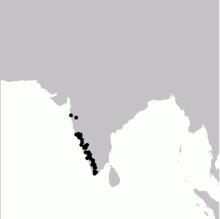Malabar grey hornbill
| Malabar grey hornbill | |
|---|---|
 | |
| Female with dark base of lower bill (Thattekad, Kerala) | |
 | |
| Male in Kerala, India | |
| Conservation status | |
| Scientific classification | |
| Kingdom: | Animalia |
| Phylum: | Chordata |
| Class: | Aves |
| Order: | Bucerotiformes |
| Family: | Bucerotidae |
| Genus: | Ocyceros |
| Species: | O. griseus |
| Binomial name | |
| Ocyceros griseus (Latham, 1790) | |
 | |
| Synonyms | |
|
Tockus griseus | |
The Malabar grey hornbill (Ocyceros griseus) is a hornbill endemic to the Western Ghats and associated hills of southern India. They have a large beak but lack the casque that is prominent in some other hornbill species. They are found mainly in dense forest and around rubber, arecanut or coffee plantations.[2] They move around in small groups, feeding on figs and other forest fruits. Their loud cackling and laughing call makes them familiar to people living in the region.
Description

The Malabar grey hornbill is a large bird, but mid-sized for a hornbill, at 45 to 58 cm (18 to 23 in) in length. It has a 23 cm (9.1 in) tail and pale or yellowish to orange bill.[3] Males have a reddish bill with a yellow tip, while the females have a plain yellow bill with black at the base of the lower mandible and a black stripe along the culmen. They show a broad whitish superciliary band above the eye, running down to the neck. They fly with a strong flap and glide flight and hop around heavily on the outer branches of large fruiting trees. They have brown-grey wings, a white carpal patch and black primary flight feathers tipped with white. The Indian grey hornbill, which is found mainly on the adjoining plains, is easily told apart by its prominent casque, and in flight by the white trailing edge of the entire wing. The Malabar grey hornbill has a grey back and a cinnamon vent. The long tail is blackish with a white tip, and the underparts are grey with white streaks. The long curved bill has no casque. Immature birds have browner upperparts and a yellow bill.[4] Young birds have a dull white or yellow iris.[5][6]
Their loud calls are distinctive and include "hysterical cackling", "laughing" and "screeching" calls. (![]() Cackle calls
Cackle calls ![]() Screeches )[7]
Screeches )[7]
Distribution
The Malabar grey hornbill is a common resident breeder in the Western Ghats and associated hills of southern India. They are found mainly in dense forest habitats; the thinner dry forest habitat of the plains is typically occupied by the Indian grey hornbill. The Sri Lanka grey hornbill was included with this species in the past, but is now considered distinct.[4]
Behaviour and ecology
This hornbill is found in small groups mainly in habitats with good tree cover. Being large frugivores, they are important as seed dispersal agents for many species of fruit bearing forest trees.[8] They also feed on small vertebrates and in captivity they will readily take meat.[9]
Breeding

The breeding season is January to May. Being secondary cavity nesters (incapable of excavating their own nests), they find trees with large cavities. A study in the Anaimalai Hills showed that the species preferred nest sites that had large trees. The nest holes were usually found in large trees with hollows caused by heart-rot, where a branch had broken off.[10] Trees of the species Lagerstroemia microcarpa, Terminalia bellirica and Terminalia crenulata were found to hold nearly 70% of all the nests in the Mudumalai area.[11] The species is monogamous, and the same nest sites are used by the pair year after year. The female incarcerates herself within the cavity by sealing its entrance with a cement made from her droppings. The female then lays three or sometimes four white eggs and begins a complete moult of her flight feathers. The entrance to the nest retains a narrow aperture through which the female voids excreta and receives food from the male. The male brings all the food needed for the female and the young. Berries, insects, small rodents and reptiles are included in the diet. Males tap the tree to beckon the female on arriving with food.[12] Berries are regurgitated one at a time and shifted to the tip of the bill before being passed to the female.[7]
References
- ↑ BirdLife International (2012). "Ocyceros griseus". IUCN Red List of Threatened Species. Version 2013.2. International Union for Conservation of Nature. Retrieved 26 November 2013.
- ↑ Ranganathan, J; Daniels, RJ; Chandran, MD; Ehrlich, PR; Daily, GC (November 2008). "Sustaining biodiversity in ancient tropical countryside". Proc. Nat. Acad. Sci. 105 (46): 17852–17854. doi:10.1073/pnas.0808874105. PMC 2577706. PMID 18981411.
- ↑ Ali, S. (1993). The Book of Indian Birds. Bombay: Bombay Natural History Society. ISBN 0-19-563731-3.
- ↑ 4.0 4.1 Rasmussen, PC and Anderton, JC (2005). Birds of South Asia: The Ripley Guide. Smithsonian Institution and Lynx Editions. Vol. 2. p. 272.
- ↑ Blanford, W. T. (1895). Fauna of British India. Birds. Volume 3. London: Taylor and Francis. pp. 156–157.
- ↑ Baker, ECS. Fauna of British India. Birds. Volume 4 (2 ed.). London: Taylor and Francis. pp. 303–304.
- ↑ 7.0 7.1 Ali, S. & Ripley, S. D. (1983). Handbook of the Birds of India and Pakistan. Volume 4. (2 ed.). New Delhi: Oxford University Press. pp. 132–133.
- ↑ Mudappa, Divya (2000). "Breeding biology of the Malabar Grey Hornbill (Ocyceros griseus) in southern Western Ghats, India". J. Bombay Nat. Hist. Soc. 97 (1): 15–24.
- ↑ Abdulali, Humayun (1951). "Some notes on the Malabar Grey Hornbill [Tockus griseus (Bath.)]". J. Bombay Nat. Hist. Soc. 50 (2): 403–404.
- ↑ Mudappa, D.C., Kannan, R. (1997). "Nest-site characteristics and nesting success of the Malabar Gray Hornbill in the southern Western Ghats, India". Wilson Bull. 102–111 (1).
- ↑ Maheswaran B., Balasubramanian P. (2003). "Nest tree utilization by the Malabar Grey Hornbill Ocyceros griseus in the semi-evergreen forest of Mudumalai Wildlife Sanctuary (S India)". Acta Ornithol. 38: 33–37. doi:10.3161/068.038.0108.
- ↑ Abdulali, Humayun (1942). "The nesting of the Malabar Grey Hornbill". J. Bombay Nat. Hist. Soc. 43 (1): 102–103.
External links
| Wikimedia Commons has media related to Ocyceros griseus. |
| Wikispecies has information related to: Ocyceros griseus |
- Internet Bird Collection
- Wieke Galama, Catherine King, Koen Brouwer (2002). "EAZA Hornbill Management and Husbandry Guidelines". National Foundation for Research in Zoological Gardens.
